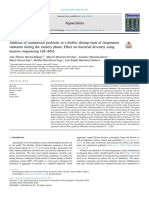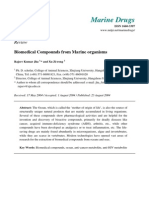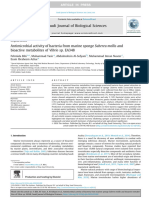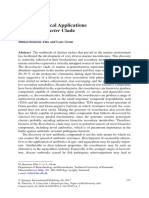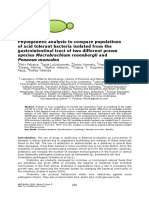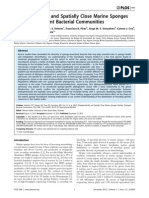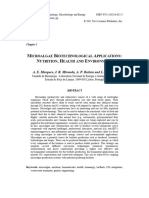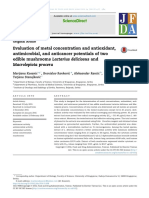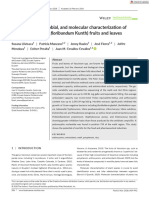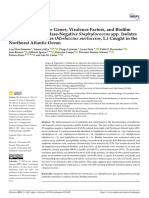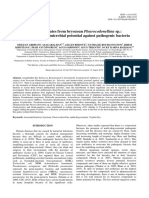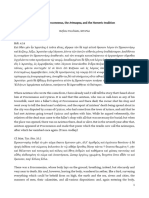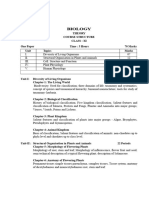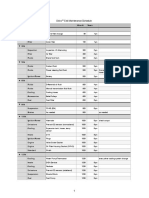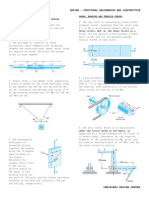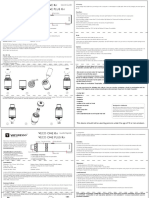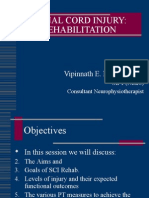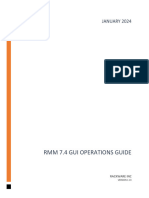Marine Drugs: Antibacterial Compounds From Marine Vibrionaceae Isolated On A Global Expedition
Marine Drugs: Antibacterial Compounds From Marine Vibrionaceae Isolated On A Global Expedition
Uploaded by
Sergio PincayCopyright:
Available Formats
Marine Drugs: Antibacterial Compounds From Marine Vibrionaceae Isolated On A Global Expedition
Marine Drugs: Antibacterial Compounds From Marine Vibrionaceae Isolated On A Global Expedition
Uploaded by
Sergio PincayOriginal Title
Copyright
Available Formats
Share this document
Did you find this document useful?
Is this content inappropriate?
Copyright:
Available Formats
Marine Drugs: Antibacterial Compounds From Marine Vibrionaceae Isolated On A Global Expedition
Marine Drugs: Antibacterial Compounds From Marine Vibrionaceae Isolated On A Global Expedition
Uploaded by
Sergio PincayCopyright:
Available Formats
Mar. Drugs 2010, 8, 2946-2960; doi:10.
3390/md8122946
OPEN ACCESS
Marine Drugs
ISSN 1660-3397 www.mdpi.com/journal/marinedrugs Article
Antibacterial Compounds from Marine Vibrionaceae Isolated on a Global Expedition
Matthias Wietz 1,, Maria Mansson 2,, Charlotte H. Gotfredsen 3, Thomas O. Larsen 2 and Lone Gram 1,*
1
National Food Institute, Technical University of Denmark, 2800 Kgs. Lyngby, Denmark; E-Mail: mwie@food.dtu.dk Centre for Microbial Biotechnology, Department of Systems Biology, Technical University of Denmark, 2800 Kgs. Lyngby, Denmark; E-Mails: maj@bio.dtu.dk (M.M.); tol@bio.dtu.dk (T.O.L.) Department of Chemistry, Technical University of Denmark, 2800 Kgs. Lyngby, Denmark; E-Mail: chg@kemi.dtu.dk These authors contributed equally to this work.
* Author to whom correspondence should be addressed; E-Mail: gram@food.dtu.dk; Tel.: +45-4525-2586; Fax: +45-4588-4774. Received: 4 November 2010; in revised form: 1 December 2010 / Accepted: 9 December 2010 / Published: 13 December 2010
Abstract: On a global research expedition, over 500 bacterial strains inhibitory towards pathogenic bacteria were isolated. Three hundred of the antibacterial strains were assigned to the Vibrionaceae family. The purpose of the present study was to investigate the phylogeny and bioactivity of five Vibrionaceae strains with pronounced antibacterial activity. These were identified as Vibrio coralliilyticus (two strains), V. neptunius (two strains), and Photobacterium halotolerans (one strain) on the basis of housekeeping gene sequences. The two related V. coralliilyticus and V. neptunius strains were isolated from distant oceanic regions. Chemotyping by LC-UV/MS underlined genetic relationships by showing highly similar metabolite profiles for each of the two V. coralliilyticus and V. neptunius strains, respectively, but a unique profile for P. halotolerans. Bioassay-guided fractionation identified two known antibiotics as being responsible for the antibacterial activity; andrimid (from V. coralliilyticus) and holomycin (from P. halotolerans). Despite the isolation of already known antibiotics, our findings show that marine Vibrionaceae are a resource of antibacterial compounds and may have potential for future natural product discovery.
Mar. Drugs 2010, 8 Keywords: Vibrio coralliilyticus; Vibrio neptunius; Photobacterium halotolerans; chemotyping; andrimid; holomycin
2947
1. Introduction Bioactive secondary metabolites are believed to play a key role in microbial interactions by mediating antagonistic activity and intercellular communication [1]. In addition, many microbial natural products have biotechnological potential as antibiotics, biosurfactants, antifungal, or anticancer agents [2]. Sequences of microbial genomes revealed that only a small fraction of the natural product diversity is known, highlighting the potential for finding novel bioactive compounds in environmental microorganisms [3]. The need for novel antimicrobials to combat increasing antibiotic resistances in pathogenic bacteria has stimulated the exploration of other than the traditional sources, such as terrestrial actinomycetes or fungi [4]. The marine environment harbors bacteria with antagonistic traits [5,6], and marine microorganisms are a potential source of novel antimicrobials [7]. Antagonistic marine bacteria have been isolated from surface [8] and deep waters [9], but the majority originated from biotic surfaces such as sponges [10], zooplankton and macroalgae [8,11], corals [12], and bryozoans [13]. Bioactive bacterial strains predominantly belong to Pseudoalteromonas spp. [14], the Roseobacter clade [15], and Actinobacteria [16]. A number of marine-derived antimicrobials have been characterized in greater detail, including halogenated [17] and sulfuric [18] compounds, depsipeptides [19] and lipopeptides [20], glycolipids [21], as well as high molecular weight structures such as amino acid oxidases [22]. Also the Vibrionaceae family, Gram-negative Gammaproteobacteria ubiquitous in marine and brackish environments [23], harbors strains with antagonistic activity [8]. The family comprises eight genera, with Vibrio and Photobacterium constituting the majority of species. To date, Vibrionaceae have primarily been investigated due to their pathogenic potential to humans and aquatic animals, but they also occur in commensal or symbiotic associations with eukaryotic organisms [23]. While the abundance of Vibrionaceae in nutrient-rich microenvironments such as chitinous zooplankton is potentially related to a superior nutrient utilization based on their metabolic versatility [24], antagonism of competing bacteria through production of antimicrobial compounds may also contribute to a selective advantage. Antimicrobials from Vibrio spp. can reduce the number of other microbial community members and influence microscale variations in competing bacterial populations [6]. Antibacterial activities have been described from V. alginolyticus [25], V. parahaemolyticus [26], V. anguillarum [27], and several unidentified Vibrio spp. [28,29]. However, the nature and frequency of antagonism among vibrios is still largely unknown, and only a few antibiotic Vibrio compounds have been structure elucidated to date [30,31]. The present study describes the analysis of bioactive Vibrionaceae strains collected during a global marine expedition [8]. The purpose was to (i) provide phylogenetic and chemical analyses of the strains with strongest antibacterial activity; (ii) characterize their bioactivity depending on culture conditions; and (iii) isolate and elucidate the structure of bioactive metabolites. We report the
Mar. Drugs 2010, 8
2948
identification of five Vibrionaceae strains with pronounced antibacterial activity, the use of chemotyping to support genetic identification, and the structures of two antibacterial compounds. 2. Results and Discussion 2.1. Selection of Strains with Pronounced Antibacterial Activity Three hundred and one Vibrionaceae strains were isolated during a global marine expedition (http://www.galathea3.dk/uk) based on their ability to antagonize the fish pathogen Vibrio anguillarum strain 90-11-287 [8]. After being stored at 80 C for between six and 12 months, all strains were retested for antibacterial activity against V. anguillarum strain 90-11-287 and the human pathogen Staphylococcus aureus strain 8325 by spotting colony mass on pathogen-seeded agar [8]. Activity was assessed by the formation of clearing zones around spotted colony mass. From 301 strains, only 138 retained antibacterial activity, being a small fraction compared to other antagonistic marine bacteria [32,33]. One hundred strains causing pronounced inhibition (diameter of clearing zones larger than 10 mm) were retested using the same set-up, resulting in a subselection of 39 strains with reproducible strong antibacterial activity when spotted on pathogen-seeded agar. This subselection was inoculated in liquid cultures and extracted with ethyl acetate to determine if antibacterial compounds were extractable with organic solvent. Activity was seen in ethyl acetate extracts from five strains, which were selected for further analyses. The five bioactive strains originated from different surface samples collected in distant oceanic regions (Figure 1). Figure 1. Site of isolation, source, and species identification of five bioactive marine Vibrionaceae. Strains were identified to the species level by sequence analysis of several housekeeping genes (see below).
Mar. Drugs 2010, 8 2.2. Phylogenetic Identification and Chemotyping of Strains
2949
All strains investigated in the present study had previously been assigned to the Vibrionaceae family based on 16S rRNA gene similarities [8]. However, the 16S rRNA gene is highly conserved among the Vibrionaceae and is not well suited for identification to the species level [34]. Therefore, additional sequence analyses of three housekeeping genes (recA, rpoA, and toxR) were performed. These genes encode constitutively expressed proteins and are suitable for phylogenetic studies of Vibrionaceae [34,35]. On the basis of recA and rpoA sequence similarities, strains S2052 and S4053 were identified as Vibrio coralliilyticus, S2394 and S4051 as Vibrio neptunius, and S2753 as Photobacterium halotolerans (Figure 1). The toxR gene was less suited for general species identification due to its high variability even in closely related vibrios, as well as comparatively few toxR sequence data available in public gene libraries [36]. However, multiple alignments and neighbor-joining analyses of toxR sequences provided the best phylogenetic resolution for determining the relationship between the five strains (Figure 2). The usefulness of toxR for species discrimination was consistent with previous reports [35]. LC-UV/MS metabolite profiles underlined the close relationship between V. coralliilyticus S2052/4053 and V. neptunius S2394/4051, respectively. The evolutionary distance of P. halotolerans S2753 to the other strains was reflected by a unique metabolite profile (Figure 2). All five strains were consistent in their metabolite production in separate cultivations over a one-year interval. Several metabolites were produced by all V. coralliilyticus and V. neptunius strains, for instance those related to the peaks at retention times Rt = 11.08 and 12.03 min (Figure 2). Although they are different species, V. coralliilyticus and V. neptunius are closely related vibrios with only 23% sequence variation in the recA and rpoA genes (data not shown), signifying why biosynthetic pathways are shared between the species. Based on their molecular formulas, UV, and MS characteristics [37], most of the metabolites produced by both species were assigned as smaller peptides (m/z 300500), a class of molecules commonly produced by marine culturable bacteria [38,39]. Despite the presence of shared metabolites between V. coralliilyticus and V. neptunius, clearly distinguishable peaks were seen as well. For instance, the major peak at retention time Rt = 10.02 min (MW 479 Da) was only seen in the two V. coralliilyticus, and the peak at Rt = 10.11 min (MW 493 Da) only in the two V. neptunius strains. The metabolites produced by P. halotolerans S2753 comprised a series of larger peptides (m/z 500900) [40]. The large peak at Rt = 1.70 min (MW 213 Da) displayed a unique UV spectrum characteristic of that of a highly conjugated system. However, this peak could not be ascribed to any known compound or compound class based on LC-UV/MS data alone. Several metabolites (Rt = 4.70, 7.41, 8.60, 9.60, and 10.50 min) were found in all five strains and assigned as poly--hydroxybutyric acid polymers (PHB) of varying lengths (repeating unit n = 86 Da). This was verified by NMR for some of the compounds (data not shown). PHB are common bacterial storage compounds accumulated when growing on an excess carbon source [41].
Mar. Drugs 2010, 8
100
2950
Figure 2. Phylogenetic and chemical relationship between five bioactive Vibrionaceae based on neighbor-joining analyses of aligned toxR gene sequences and LC-MS Total Ion Chromatograms (TIC). The scale bar relates to the number of base substitutions in toxR gene sequences (as displayed by branch lengths in the phylogenetic tree).
0 V. neptunius 2.00
4.00
6.00
8.00
10.00
12.00
14.00
16.00
18.00
20.00
7.43
100 100
11.08 11.56 8.60 9.72 12.40 13.40
S2394
% %
3.67
9.62 10.11
0 0
2.00 2.00
4.00 4.00
6.00 6.00
8.00 8.00
10.00 10.00
12.00 12.00
14.00
16.00
18.00
Time 20.00
100
7.12
8.77
11.08 11.56
100
S4051
8.60 10.11 7.43 9.62
12.40 13.40
3.67
2.00 4.00 6.00 8.00 10.00 12.00 14.00 16.00 18.00 Time 20.00
0 V. coralliilyticus 2.00 4.00
6.00
8.00
10.00
12.00
14.00
16.00
18.00
20.00
10.02
100 100
5.91 7.12
8.77
11.08 12.03 12.95 18.64
S2052
% %
0 0
2.00 2.00
4.00 4.00
6.00 6.00
8.00 8.00
10.00 10.00
12.00 12.00
14.00
16.00
18.00
Time 20.00
100
8.77 7.12
12.03
100
10.02 11.08
12.95
S4053
%
0 2.00
0
4.00
6.00
8.00
10.00
12.00
14.00
16.00
18.00
Time 20.00
2.00 4.00 P. halotolerans
6.00
8.00
10.00
12.00
14.00
100 100
15.34 14.75 16.05 16.95
16.00
18.00
20.00
S2753
% %
1.70 13.70 13.25
18.55
0 0
0.05
100
2.00 2.00
4.00 4.00
6.00 6.00
8.00 8.00
10.00 10.00
12.00 12.00
14.00
16.00
18.00
Time 20.00
Mar. Drugs 2010, 8
2951
Chemotyping of prokaryotes has mostly been restricted to analyses of fatty acids and sugars [42], but we show that also the profiling of small molecules can be used for species discrimination. This highlights the usefulness of metabolomics for bacterial classification, adding to recent work of whole-cell laser desorption MALDI-TOF mass spectrometry for characterization of vibrios [43] and secondary metabolite profiling to assess the biosynthetic potential of marine Pseudoalteromonas [32]. While our study is limited to the analysis of only three species from the Vibrionaceae family, the isolation of two genetically and chemically closely related strain siblings from distant oceanic regions indicated that production of certain secondary metabolites is a preserved trait. Similar secondary metabolite profiles were also shown for marine actinomycetal Salinispora spp. [44] from distant habitats. Also, all Ruegeria mobilis strains from worldwide locations produced the same antibiotic, tropodithietic acid [33]. 2.3. Bioassay-Guided Identification of Antibacterial Compounds V. coralliilyticus (strains S2052 and S4053) and P. halotolerans (S2753) inhibited both V. anguillarum and S. aureus, whereas V. neptunius (strains S2394 and S4051) only inhibited V. anguillarum (Table 1). Antibacterial activity was highest in aerated cultures and detected after one, three, and five days of incubation. No significant difference in activity was seen between the tested culture media. Table 1. Inhibition of V. anguillarum strain 90-11-287 and S. aureus strain 8325 by ethyl acetate extracts from five marine Vibrionaceae. Antibacterial activity is displayed by the diameter of clearing zones (: no activity; +: between 0 and 15 mm; ++: between 15 and 30 mm; +++: over 30 mm). Strain S2052 S2394 S2753 S4051 S4053 Species V. coralliilyticus V. neptunius P. halotolerans V. neptunius V. coralliilyticus Inhibition of V. anguillarum S. aureus +++ ++ ++ +++ ++ ++ ++ +
The finding of bioactivity among marine Vibrionaceae underlined marine microorganisms being a source of antimicrobials. To our knowledge, none of the species investigated here have previously been studied with respect to their secondary metabolome including antibacterial compounds. To identify the compounds responsible for the observed activity, large-scale cultivations and fractionations were undertaken for V. coralliilyticus S2052 and P. halotolerans S2753, representing two distant Vibrionaceae species with different metabolite profiles. All fractionation steps were guided by activity testing against V. anguillarum strain 90-11-287. Initial dereplication of S2052 by LC-UV/MS [37] and explorative solid-phase extraction (E-SPE) [45] indicated that andrimid (Rt = 10.02 min; Figure 2) could be responsible for the antibacterial activity. This compound (Figure 3a), a hybrid nonribosomal peptide-polyketide antibiotic, was first described from an insect endosymbiont [46] and later found in other microbial species [47,48] including marine
Mar. Drugs 2010, 8
2952
vibrios [29,31]. Pure andrimid was isolated for NMR analysis, and our data was in accordance with literature data [47]. Andrimid acts as an acetyl-CoA carboxylase inhibitor [49], and we extended its broad antibiotic spectrum [50] by showing inhibition of the bacterial pathogens Salmonella Enteritidis, Bacillus cereus, Yersinia enterolitica, Yersinia ruckeri, Vibrio harveyi, and Vibrio vulnificus (data not shown). Production of andrimid was also confirmed for the other isolated V. coralliilyticus strain, S4053. We furthermore speculate whether a recent report of antagonism in the V. coralliilyticus type strain [12] was also attributed to this compound. Previous studies have revealed almost identical andrimid gene clusters and a transposase pseudogene in two producer species, suggesting horizontal gene transfer as the most likely explanation behind the cosmopolitanism of the antibiotic [51]. We hypothesize that such transfer is also the reason for its presence in V. coralliilyticus S2052 and S4053. Our study is the first linking andrimid production to a specific Vibrio species, with production occurring in two strains isolated from very different geographical regions and sources. The antibacterial compound of P. halotolerans S2753 was identified as holomycin (Rt = 1.70 min; Figure 2), a compound belonging to the pyrrothine class of antibiotics acting by interference with RNA synthesis [52]. Our NMR data (Figure 3b) was consistent with previous reports [53]. Holomycin has until now only been found in Gram-positive Streptomyces [54,55], and the present study is the first demonstrating production of this antibiotic in a Gram-negative heterotrophic bacterium. While parallel evolution of this trait is possible, horizontal gene transfer is the more likely explanation for its occurrence in both Vibrionaceae and actinomycetes. We extended the broad-spectrum activity of holomycin [52] by showing inhibition of the bacterial pathogens Listeria monocytogenes, Serratia marcescens, S. Enteritidis, B. cereus, Y. enterolitica, Y. ruckeri, V. harveyi, V. vulnificus and V. parahaemolyticus, as well as of several marine strains from the Roseobacter and Pseudoalteromonas groups (data not shown). Figure 3. Structures of andrimid (a) and holomycin (b) isolated from marine Vibrionaceae.
a)
6
b)
O NH
2 1 1'
O
8''' 1'''
5'' 4''
4'
O
1''
5'
O O
7
H N NH
6
NH
NH
Neither andrimid nor holomycin were produced by V. neptunius S2394 and S4051, and further fractionation and purification is needed to identify the compound(s) responsible for their antibacterial activity. Interestingly, V. neptunius S4051 and V. coralliilyticus S4053 were isolated from the same seaweed sample, showing that two antagonistic Vibrio species whose antibacterial activity is based on different compounds co-occur in the same microenvironment. Moreover, the same sample also contained an antibiotic-producing Pseudoalteromonas strain [8]. Two of the antagonistic Vibrionaceae species harbor pathogenic strains, with V. coralliilyticus being pathogenic to corals [56] and V. neptunius being pathogenic to oysters [57]. While we do not know whether V. coralliilyticus S2052 has pathogenic potential, the V. coralliilyticus type strain has both antagonistic and pathogenic traits [12]. Hence, our results suggest that some vibrios possess a
Mar. Drugs 2010, 8
2953
dual physiology, being antagonistic against other prokaryotes but pathogenic towards higher organisms. Moreover, the production of antibiotics in several species suggests that these compounds may be of ecological importance [1]. This study highlights one of the challenges in natural product discovery. Despite major screening efforts for novel antimicrobials to be used in pharmaceutical, food, and aquaculture industries, only a limited amount of compounds have been discovered in recent years [58]. While the isolation of culturable bacteria remains a promising approach [42] and the secondary metabolome of marine vibrios has not been extensively studied, we only isolated known compounds despite careful dereplication prior to any compound purification. Dereplication is apparently troubled by the high degree of gene transfer between distantly related bacteria such as Gram-positive actinomycetes and Gram-negative Proteobacteria [3]. Many compounds in natural product databases such as AntiBase [59] have similar masses (<5 ppm difference), so even the combination of UV/VIS spectra, accurate mass data (<5 ppm), and E-SPE [45] is not sufficiently discriminatory for these organisms. To avoid isolation of redundant chemistry, dereplication by NMR [60] or ultra high-resolution mass spectrometry (<1 ppm) with high isotope accuracy ratios for correct elementary composition determination [61] is imperative to exclude previously isolated compounds. 3. Experimental Section 3.1. Isolation of Bioactive Marine Vibrionaceae During a global research expedition (http://www.galathea3.dk/uk), marine bacterial strains were isolated from environmental samples and screened for antagonistic activity against a pathogenic Vibrio anguillarum, strain 90-11-287. Three hundred and one bioactive strains were identified as Vibrionaceae based on 16S rRNA gene similarities [8]. Pure cultures of strains were stored in cryoprotectant solution at 80 C until being analyzed in the present study. 3.2. Selection of Strains with Pronounced Antibacterial Activity All 301 strains were retested for antibacterial activity by spotting colony mass on agar seeded with either V. anguillarum strain 90-11-287 or S. aureus strain 8325. Activity was assessed by the formation of clearing zones around spotted colony mass. Selected active strains were grown both stagnant and aerated (200 rpm) in 30 mL Marine Broth 2216 (Difco 279110) for 3 days at 25 C in 250 mL glass bottles. Cultures were extracted with an equal volume of HPLC-grade ethyl acetate (EtOAc) for 30 min. The organic phase was transferred to fresh sample vials and evaporated under nitrogen until dryness. Extracts were redissolved in 1 mL of EtOAc and stored at 20 C until further analysis. EtOAc extracts were tested in a well diffusion agar assay [62] for activity against V. anguillarum strain 90-11-287 and S. aureus strain 8325. 3.3. Phylogenetic Analysis Genomic DNA was extracted from 1-day cultures using the NucleoSpin Tissue Kit (Macherey-Nagel, D ren, Germany) according to the manufacturer's instructions. PCR for recA and toxR gene fragments was performed according to [35], and PCR for rpoA gene fragments according to [34]. PCR products
Mar. Drugs 2010, 8
2954
were checked by agarose gel electrophoresis and purified using the Wizard PCR Preps DNA Direct Purification System (Promega, Madison, USA) according to the manufacturers instructions. Obtained nucleotide sequences were edited using Chromas Lite (Technelysium, Australia) and aligned to its closest sequence relative [36]. The phylogenetic relationship between the five isolates was determined by neighbor-joining analyses (1000 bootstrap replicates) of nucleotide and amino acid alignments (translated using EMBOSS Transeq, http://www.ebi.ac.uk/Tools/emboss/transeq/) done in ClustalX. Gene sequences have been deposited at GenBank under the accession numbers HQ452614452618 (toxR), HQ452619452623 (recA), and HQ452624452628 (rpoA). 3.4. Influence of Culture Conditions on Bioactivity The five strains with strongest antibacterial activity (S2052, S2394, S2753, S4051, and S4053) were grown both stagnant and aerated (200 rpm) at 25 C in either Marine Broth (MB) or Marine Minimal Medium [63] containing 0.4% glucose and 0.3% casamino acids (MMM). Per strain and culture condition, three bottles were inoculated with 30 mL of medium each, of which each one was sampled after 1, 3, and 5 days of incubation. In addition, strains were grown in 30 mL sea salt solution (Sigma S9883; 40 g L1) with 0.4% glucose and 0.3% casamino acids for 3 days (200 rpm) at 25 C. EtOAc extracts were prepared as described above, and tested in a well diffusion agar assay [62] for activity against V. anguillarum strain 90-11-287 and S. aureus strain 8325. 3.5. Chemotyping Liquid chromatography-diode array/mass spectrometry (LC-UV/MS) analyses were performed on dried EtOAc extracts redissolved in methanol (MeOH) from all tested culture conditions to visualize the array of produced molecules. In addition, 3-day MMM cultures were extracted and analyzed in biological triplicate. LC-UV/MS was performed on an Agilent 1100 liquid chromatograph with a diode array detector (Agilent, Waldbronn, Germany) coupled to an LCT TOF mass spectrometer (Micromass, Manchester, UK) using a Z-spray ESI source. The separation was done on a Luna II C18 column (50 mm 2 mm, 3 m) (Phenomenex, Torrance, CA) fitted with a security guard system using a linear gradient starting from 15% acetonitrile (MeCN) in water (H2O) to 100% MeCN over 20 min at a flow rate of 300 L min1. Both MeCN (HPLC grade) and H2O were buffered with 20 mM HPLC-grade formic acid (FA). 3.6. Isolation and Structural Elucidation of Antibacterial Compounds Strains S2052 and S2753 were grown in 20 L sea salt solution (Sigma S9883; 40 g L1) with 0.4% glucose and 0.3% casamino acids for 3 days (100 rpm) at 25 C. On day 3, sterile Dianion HP20SS resin (Sigma-Aldrich, St. Louis, MO) was added to the broth (12 g of resin L1). After 24 h, the resin was filtered off and washed with H2O (2 1 L), followed by extraction with MeCN/H2O (80/20 v/v; 2 1500 mL). For S2052, all organic extracts were pooled, absorbed onto 90 g Sepra ZT C18 (Phenomenex), and dried before packing into a 100 g SNAP column (Biotage, Uppsala, Sweden) with pure resin (10 g) in the base. Using an Isolera flash purification system (Biotage), the extract was subjected to a crude
Mar. Drugs 2010, 8
2955
fractionation using a MeCN/H2O gradient (flow rate 30 mL min1) starting with 10% MeCN (10 min, isocratic), increasing to 100% MeCN (25 min) before washing with 100% MeCN (15 min). Fractions were automatically collected using UV detection (210 and 320 nm). The fraction with antibacterial activity (185 mg) was subjected to further purification on a Luna II C18 column (250 10 mm, 5 m) (Phenomenex) using a 4570% MeCN/H2O gradient (buffered with 20 mM FA, flow rate 5 mL min1) over 20 minutes on a Gilson 322 liquid chromatograph with a 215 liquid handler/injector (BioLab, Risskov, Denmark). This yielded 7.6 mg of pure andrimid. For S2753, the MeCN/H2O extract from Dianion HP20SS extraction was evaporated until dryness on a rotary evaporator. The extract was redissolved in EtOAc, absorbed onto 5 g Isolute diol (Biotage), and added to a glass column with pure diol (95 g). A total of 12 fractions were collected from the diol column (100 g, 20 350 mm) ranging from heptane, dichloromethane, EtOAc to pure MeOH, running under gravity. The fraction with antibacterial activity (172 mg, 100% EtOAc) was further separated on the Isolera flash purification system, on Sepra ZT C18 (10 g SNAP) using a MeCN/H2O gradient (flow rate 12 mL min1) starting with 5% MeCN increasing to 30% MeCN (12 min), quickly increasing to 100% MeCN (10 min). Fractions were automatically collected using UV detection (210 and 380 nm). Pure holomycin (4.3 mg) was obtained after final purification on a Luna II C18 column (250 10 mm, 5 m) (Phenomenex) using a MeCN/H2O (buffered with 20 mM FA) gradient from 737% MeCN over 17 min. NMR spectra were recorded on a Bruker Avance 800 MHz spectrometer with a 5 mm TCI Cryoprobe at the Danish Instrument Center for NMR Spectroscopy of Biological Macromolecules, using standard pulse sequences. The NMR data used for the structural assignment of andrimid and holomycin were acquired in DMSO-d6 (H 2.49 and C 39.5 ppm). Optical rotation was measured on a Perkin Elmer Model 341 polarimeter (Perkin Elmer, Waltham, MA) (D at 589 nm). Andrimid: orange-yellow amorphous solid; UV (MeCN/H2O) max 200 (100%), 280 (40%) nm; []D20 62.9(c 0.24, MeOH); 1H NMR H ppm: 0.75 (3H, d, 6.7 Hz, H-4), 0.80 (3H, d, 6.7 Hz, H-5), 1.07 (d, 7.2 Hz, 1H, H-6), 1.78 (3H, d, 6.7 Hz, H-8), 2.30 (m, 1H, H-3), 2.65 (1H, dd, 14.6, 6.2 Hz, H-2a), 2.77 (1H, dd, 14.6, 8.2 Hz, H-2b), 2.91 (m, 1H, H-4), 3.92 (d, 5.6 Hz, 1H, H-3), 4.62 (dd, 8.4, 5.4 Hz, 1H, H-2), 5.28 (1H, m, H-3), 5.90 (1H, m, H-7), 6.01 (1H, d, 15.2 Hz, H-2), 6.18 (1H, m, H-6), 6.26 (1H, dd, 14.5, 11.4 Hz, H-4), 6.53 (1H, dd, 14.5, 10.0 Hz, H-5), 7.00 (1H, dd, 15.2, 11.4 Hz, H-3), 7.20 (1H, m, H-7), 7.29-7.31 (4H, m, H-5/H-6), 8.11 (1H, d, 8.4 Hz, NH-2), 8.42 (1H, d, 8.5 Hz, NH-3), 11.36 ( s, 1H, NH-1); 13C NMR C ppm: 14.5 (C-6), 17.2 (C-4), 18.3 (C-8), 19.4 (C-5), 28.1 (C-3), 39.0 (C-4), 41.9 (C-2), 57.8 (C-3), 63.1 (C-2), 124.2 (C-2), 126.4 (C-5), 126.9 (C-7), 128.1 (C-4), 128.2 (C-6), 131.5 (C-6), 133.4 (C-7), 139.0 (C-5), 139.4 (C-3), 142.9 (C-4), 164.3 (C-1), 169.9 (C-1), 173.8 (C-2), 180.0 (C-5), 203.9 (C-1); HRESIMS m/z 479.2435 (calcd for C27H33N3O5, 479.2420). Holomycin: orange-yellow prisms; UV (MeCN/H2O) max 200 (100%), 280 (40%) nm; 1H NMR H ppm: 2.01 (s, 1H, H-9), 7.04 (s, 1H, H-1), 9.86 (s, 1H, NH-7), 10.69 (s, 1H, NH-3); 13C NMR C ppm: 22.4 (C9), 110.6 (C-1), 115.4 (C-5), 133.7 (C-2), 133.9 (C-6), 167.9 (C-4), 168.8 (C-8); HRESIMS m/z 213.9860 (calcd for C7H6N2O2S2, 213.9871).
Mar. Drugs 2010, 8 4. Conclusions
2956
The present study adds to the knowledge of Vibrionaceae bioactivity and physiology by showing a worldwide occurrence of marine strains producing antibacterial compounds. In addition, we underlined that chemotyping can support gene-based species identification and help resolving phylogenetic relationships within a genetically homogenous family such as the Vibrionaceae. The discovery of known antibiotics that are also produced by evolutionary distant microbes suggests an involvement of horizontal gene transfer, and indicates that these compounds are fundamental to compete and communicate in the natural habitat. The cosmopolitanism of identical antibiotics has major implications for natural product discovery strategies and stresses the need for careful dereplication in the initial stages of screening. An alternative approach could be the screening for largely untested bioactivities, for instance, interference with quorum sensing or modulation of gene expression. Acknowledgements We thank the Danish Instrument Center for NMR Spectroscopy of Biological Macromolecules for NMR time. Thanks to Louise Kjrulff for assisting in the purification of holomycin, and to Kamilla Spanggaard and Anja Sander for help with bioassays. Funding from the Programme Committee for Food, Health and Welfare under the Danish Strategic Research Council is acknowledged. The present work was carried out as part of the Galathea 3 expedition under the auspices of the Danish Expedition foundation. This is Galathea 3 contribution no. P70. References 1. 2. 3. 4. 5. 6. 7. 8. Hibbing, M.E.; Fuqua, C.; Parsek, M.R.; Peterson, S.B. Bacterial competition: surviving and thriving in the microbial jungle. Nat. Rev. Microbiol. 2010, 8, 1525. Demain, A.L.; Sanchez, S. Microbial drug discovery: 80 years of progress. J. Antibiot. 2009, 62, 516. Fischbach, M.A. Antibiotics from microbes: Converging to kill. Curr. Opin. Microbiol. 2009, 12, 520527. Berdy, J. Bioactive Microbial Metabolites. J. Antibiot. 2005, 58, 126. Nair, S.; Simidu, U. Distribution and Significance of Heterotrophic Marine Bacteria with Antibacterial Activity. Appl. Environ. Microbiol. 1987, 53, 29572962. Long, E.; Azam, F. Antagonistic Interactions among Marine Pelagic Bacteria. Appl. Environ. Microbiol. 2001, 67, 49754983. Zhang, L.X.; An, R.; Wang, J.P.; Sun, N.; Zhang, S.; Hu, J.C.; Kuai, J. Exploring novel bioactive compounds from marine microbes. Curr. Opin. Microbiol. 2005, 8, 276281. Gram, L.; Melchiorsen, J.; Bruhn, J.B. Antibacterial activity of marine culturable bacteria collected from a global sampling of ocean surface waters and surface swabs of marine organisms. Mar. Biotechnol. 2010, 12, 439451.
Mar. Drugs 2010, 8 9.
2957
10. 11.
12. 13.
14. 15.
16. 17. 18. 19.
20. 21.
22.
23. 24.
Hohmann, C.; Schneider, K.; Bruntner, C.; Irran, E.; Nicholson, G.; Bull, A.T.; Jones, A.L.; Brown, R.; Stach, J.E.M.; Goodfellow, M.; et al. Caboxamycin, a new antibiotic of the benzoxazole family produced by the deep-sea strain Streptomyces sp. NTK 937. J. Antibiot. 2009, 62, 99104. Taylor, M.W.; Radax, R.; Steger, D.; Wagner, M. Sponge-Associated Microorganisms: Evolution, Ecology, and Biotechnological Potential. Microbiol. Mol. Biol. Rev. 2007, 71, 295347. Wiese, J.; Thiel, V.; Nagel, K.; Staufenberger, T.; Imhoff, J.F. Diversity of Antibiotic-Active Bacteria Associated with the Brown Alga Laminaria saccharina from the Baltic Sea. Mar. Biotechnol. 2009, 11, 287300. Rypien, K.L.; Ward, J.R.; Azam, F. Antagonistic interactions among coral-associated bacteria. Environ. Microbiol. 2010, 12, 2839. Herndl, H.; Wiese, J.; Thiel, V.; Imhoff, J.M. Phylogenetic diversity and antimicrobial activities of bryozoan-associated bacteria isolated from Mediterranean and Baltic Sea habitats. Syst. Appl. Microbiol. 2010, 33, 94104. Bowman, J.P. Bioactive Compound Synthetic Capacity and Ecological Significance of Marine Bacterial Genus Pseudoalteromonas. Mar. Drugs 2007, 5, 220241. Martens, T.; Gram, L.; Grossart, H.P.; Kessler, D.; Muller, R.; Simon, M.; Wenzel, S.C.; Brinkhoff, T. Bacteria of the Roseobacter clade show potential for secondary metabolite production. Microb. Ecol. 2007, 54, 3142. Bull, A.T.; Stach, J.E.M. Marine actinobacteria: new opportunities for natural product search and discovery. Trends Microbiol. 2007, 15, 491499. Andersen, R.J.; Wolfe, M.S.; Faulkner, D.J. Autotoxic Antibiotic Production by a Marine Chromobacterium. Mar. Biol. 1974, 27, 281285. Geng, H.F.; Bruhn, J.B.; Nielsen, K.F.; Gram, L.; Belas, R. Genetic dissection of tropodithietic acid biosynthesis by marine roseobacters. Appl. Environ. Microbiol. 2008, 74, 15351545. Romanenko, L.A.; Uchino, M.; Kalinovskaya, N.I.; Mikhailov, V.V. Isolation, phylogenetic analysis and screening of marine mollusc-associated bacteria for antimicrobial, hemolytic and surface activities. Microbiol. Res. 2008, 163, 633644. Das, P.; Mukherjee, S.; Sen, R. Antimicrobial potential of a lipopeptide biosurfactant derived from a marine Bacillus circulans. J. Appl. Microbiol. 2008, 104, 16751684. Kiran, G.S.; Thomas, T.A.; Selvin, J. Production of a new glycolipid biosurfactant from marine Nocardiopsis lucentensis MSA04 in solid-state cultivation. Colloids Surf. B Biointerfaces 2010, 78, 816. Gomez, D.; Espinosa, E.; Bertazzo, M.; Lucas-Elio, P.; Solano, F.; Sanchez-Amat, A. The macromolecule with antimicrobial activity synthesized by Pseudoalteromonas luteoviolacea strains is an L-amino acid oxidase. Appl. Microbiol. Biotechnol. 2008, 79, 925930. Thompson, F.L.; Iida, T.; Swings, J. Biodiversity of Vibrios. Microbiol. Mol. Biol. Rev. 2004, 68, 403431. Farmer, J.; Hickman-Brenner, F. The Genera Vibrio and Photobacterium. In The Prokaryotes; Dworkin, M., Falkow, S., Rosenberg, E., Schleifer, K.K.-H., Stackebrandt, E., Eds.; Springer: New York, NY, USA, 2006.
Mar. Drugs 2010, 8
2958
25. Austin, B.; Stuckey, L.F.; Robertson, P.A.W.; Effendi, I.; Griffith, D.R.W. A Probiotic Strain of Vibrio alginolyticus Effective in Reducing Diseases Caused by Aeromonas salmonicida, Vibrio anguillarum and Vibrio ordalii. J. Fish Dis. 1995, 18, 9396. 26. Radjasa, O.K.; Sabdono, A.; Zocchi, J.; Zocchi, E. Richness of secondary metabolite-producing marine bacteria associated with the sponge Haliclona sp. Int. J. Pharmacol. 2007, 3, 275279. 27. Hjelm, M.; Riaza, A.; Formoso, F.; Melchiorsen, J.; Gram, L. Seasonal Incidence of Autochthonous Antagonistic Roseobacter spp. and Vibrionaceae Strains in a Turbot Larva (Scophthalmus maximus) Rearing System. Appl. Environ. Microbiol. 2004, 70, 72887294. 28. Castro, D.; Pujalte, M.J.; Lopez-Cortes, L.; Garay, E.; Borrego, J.J. Vibrios isolated from the cultured manila clam (Ruditapes philippinarum): Numerical taxonomy and antibacterial activities. J. Appl. Microbiol. 2002, 93, 438447. 29. Long, R.A.; Rowley, D.C.; Zamora, E.; Liu, J.; Bartlett, D.H.; Azam, F. Antagonistic Interactions among Marine Bacteria Impede the Proliferation of Vibrio cholerae. Appl. Environ. Microbiol. 2005, 71, 85318536. 30. Kobayashi, M.; Aoki, S.; Gato, K.; Matsunami, K.; Kurosu, M.; Kitagawa, I. Marine Natural Products. XXXIV. Trisindoline, a New Antibiotic Indole Trimer, Produced by a Bacterium of Vibrio sp. Separated from the Marine Sponge Hyrtios altum. Chem. Pharm. Bull. 1994, 42, 24492451. 31. Oclarit, J.M.; Okada, H.; Ohta, S.; Kaminura, K.; Yamaoka, Y.; Iizuka, T.; Miyashiro, S.; Ikegami, S. Anti-Bacillus Substance in the Marine Sponge, Hyatella Species, Produced by an Associated Vibrio Species Bacterium. Microbios 1994, 78, 716. 32. Vynne, N.G.; Mansson, M.; Nielsen, K.F.; Gram, L. Bioactivity, chemical profiling and 16S rRNA based phylogeny of Pseudoalteromonas strains collected on a global research cruise. Mar. Biotechnol. 2010, submitted for publication. 33. Gram, L.; Porsby, C.H.; Heilmann, J.; Jensen, M.; Melchiorsen, J.; Nielsen, K.F. A cosmopolitan bacterium: Phylogentic and phenotypic homogeneity in a global collection of Ruegeria mobilis of the Roseobacter clade. Appl. Environ. Microbiol. 2010, submitted for publication. 34. Thompson, F.L.; Gevers, D.; Thompson, C.C.; Dawyndt, P.; Naser, S.; Hoste, B.; Munn, C.B.; Swings, J. Phylogeny and molecular identification of vibrios on the basis of multilocus sequence analysis. Appl. Environ. Microbiol. 2005, 71, 51075115. 35. Pascual, J.; Macian, M.C.; Arahal, D.R.; Garay, E.; Pujalte, M.J. Multilocus sequence analysis of the central clade of the genus Vibrio by using 16S rRNA, recA, pyrH, rpoD, gyrB, rctB and toxR genes. Int. J. Syst. Evol. Microbiol. 2009, 60, 154165. 36. Altschul, S.F.; Madden, T.L.; Schaffer, A.A.; Zhang, J.H.; Zhang, Z.; Miller, W.; Lipman, D.J. Gapped BLAST and PSI-BLAST: A new generation of protein database search programs. Nucleic Acids Res. 1997, 25, 33893402. 37. Nielsen, K.F.; Smedsgaard, J. Fungal metabolite screening: database of 474 mycotoxins and fungal metabolites for dereplication by standardised liquid chromatography-UV-mass spectrometry methodology. J. Chromatogr. A 2003, 1002, 111136. 38. Mitova, M.; Popov, S.; De Rosa, S. Cyclic peptides from a Ruegeria strain of bacteria associated with the sponge Suberites domuncula. J. Nat. Prod. 2004, 67, 11781181.
Mar. Drugs 2010, 8
2959
39. Rungprom, W.; Siwu, E.R.O.; Lambert, L.K.; Dechsakulwatana, C.; Barden, M.C.; Kokpol, U.; Blanchfield, J.T.; Kita, M.; Garson, M.J. Cyclic tetrapeptides from marine bacteria associated with the seaweed Diginea sp. and the sponge Halisarca ectofibrosa. Tetrahedron 2008, 64, 31473152. 40. Mansson, M.; Nielsen, A.; Kjaerulff, L.; Gotfredsen, C.H.; Ingmer, H.; Wietz, M.; Gram, L.; Larsen, T.O. Inhibition of virulence gene expression in Staphylococcus aureus by novel depsipeptides from a marine Photobacterium. 2010, to be submitted for publication. 41. Chien, C.C.; Chen, C.C.; Choi, M.H.; Kung, S.S.; Wei, Y.H. Production of poly--hydroxybutyrate (PHB) by Vibrio spp. isolated from marine environment. J. Biotechnol. 2007, 132, 259263. 42. Bull, A.T. Microbial Diversity and Bioprospecting; ASM Press: Washington, DC, USA, 2003. 43. Dieckmann, R.; Strauch, E.; Alter, T. Rapid identification and characterization of Vibrio species using whole-cell MALDI-TOF mass spectrometry. J. Appl. Microbiol. 2010, 109, 199211. 44. Jensen, P.R.; Williams, P.G.; Oh, D.C.; Zeigler, L.; Fenical, W. Species-Specific Secondary Metabolite Production in Marine Actinomycetes of the Genus Salinispora. Appl. Environ. Microbiol. 2007, 73, 11461152. 45. Mansson, M.; Phipps, R.K.; Gram, L.; Munro, M.H.G.; Larsen, T.O.; Nielsen, K.F. Explorative Solid-Phase Extraction (E-SPE) for Accelerated Microbial Natural Product Discovery, Dereplication, and Purification. J. Nat. Prod. 2010, 73, 11261132. 46. Fredenhagen, A.; Tamura, S.Y.; Kenny, P.T.M.; Komura, H.; Naya, Y.; Nakanishi, K.; Nishiyama, K.; Sugiura, M.; Kita, H. Andrimid, a new peptide antibiotic produced by an intracellular bacterial symbiont isolated from a brown planthopper. J. Am. Chem. Soc. 1987, 109, 44094411. 47. Needham, J.; Kelly, M.T.; Ishige, M.; Andersen, R.J. Andrimid and moiramides AC, metabolites produced in culture by a marine isolate of the bacterium Pseudomonas fluorescens: Structure elucidation and biosynthesis. J. Org. Chem. 1994, 59, 20582063. 48. Jin, M.; Fischbach, M.A.; Clardy, J. A Biosynthetic Gene Cluster for the Acetyl-CoA Carboxylase Inhibitor Andrimid. J. Am. Chem. Soc. 2006, 128, 1066010661. 49. Freiberg, C.; Brunner, N.A.; Schiffer, G.; Lampe, T.; Pohlmann, J.; Brands, M.; Raabe, M.; H bich, D.; Ziegelbauer, K. Identification and Characterization of the First Class of Potent Bacterial Acetyl-CoA Carboxylase Inhibitors with Antibacterial Activity. J. Biol. Chem. 2004, 279, 2606626073. 50. Singh, M.P.; Mroczenski-Wildey, M.J.; Steinberg, D.A.; Andersen, R.J.; Maiese, W.M.; Greenstein, M. Biological activity and mechanistic studies of andrimid. J. Antibiot. 1997, 50, 270273. 51. Fischbach, M.A.; Walsh, C.T.; Clardy, J. The evolution of gene collectives: How natural selection drives chemical innovation. Proc. Natl. Acad. Sci. USA 2008, 105, 46014608. 52. Oliva, B.; ONeill, A.; Wilson, J.M.; OHanlon, P.J.; Chopra, I. Antimicrobial Properties and Mode of Action of the Pyrrothine Holomycin. Antimicrob. Agents Chemother. 2001, 45, 532539. 53. Shiozawa, H.; Kagasaki, T.; Kinoshita, T.; Haruyama, H.; Domon, H.; Utsui, Y.; Kodama, K.; Takahashi, S. Thiomarinol, A New Hybrid Antimicrobial Antibiotic Produced by A Marine Bacterium. Fermentation, Isolation, Structure, and Antimicrobial Activity. J. Antibiot. 1993, 46, 18341842.
Mar. Drugs 2010, 8
2960
54. Kenig, M.; Reading, C. Holomycin and an Antibiotic (Mm-19290) Related to Tunicamycin, Metabolites of Streptomyces clavuligerus. J. Antibiot. 1979, 32, 549554. 55. Hou, Y.H.; Li, F.C.; Wang, S.J.; Qin, S.; Wang, Q.F. Intergeneric conjugation in holomycin-producing marine Streptomyces sp. strain M095. Microbiol. Res. 2008, 163, 96104. 56. Ben-Haim, Y.; Thompson, F.L.; Thompson, C.C.; Cnockaert, M.C.; Hoste, B.; Swings, J.; Rosenberg, E. Vibrio coralliilyticus sp. nov., a temperature-dependent pathogen of the coral Pocillopora damicornis. Int. J. Syst. Evol. Microbiol. 2003, 53, 309315. 57. Prado, S.; Romalde, J.L.; Montes, J.; Barja, J.L. Pathogenic bacteria isolated from disease outbreaks in shellfish hatcheries. First description of Vibrio neptunius as an oyster pathogen. Dis. Aquat. Org. 2005, 67, 209215. 58. Li, J.W.-H.; Vederas, J.C. Drug discovery and natural products: End of an era or an endless frontier? Science 2009, 325, 161165. 59. Laatsch, H. Antibase; Wiley-VCH: Weinheim, Germany, 2010. Available online: http://www.users.gwdg.de/~ucoc/laatschAntibase.htm (accessed on 1 November 2010). 60. Lang, G.; Mayhudin, N.A.; Mitova, M.I.; Sun, L.; van der Sar, S.; Blunt, J.W.; Cole, A.L.J.; Ellis, G.; Laatsch, H.; Munro, M.H.G. Evolving trends in the dereplication of natural product extracts: New methodology for rapid, small-scale investigation of natural product extracts. J. Nat. Prod. 2008, 71, 15951599. 61. Kind, T.; Fiehn, O. Metabolomic database annotations via query of elemental compositions: Mass accuracy is insufficient even at less than 1 ppm. BMC Bioinformatics 2006, 7, 234. 62. Hjelm, M.; Bergh, I.; Riaza, A.; Nielsen, J.; Melchiorsen, J.; Jensen, S.; Duncan, H.; Ahrens, P.; Birkbeck, H.; Gram, L. Selection and Identification of Autochthonous Potential Probiotic Bacteria from Turbot Larvae (Scophthalmus maximus) Rearing Units. Syst. Appl. Microbiol. 2004, 27, 360371. 63. Ostling, J.; Goodman, A.; Kjelleberg, S. Behaviour of IncP-1 plasmids and a miniMu transposon in a marine Vibrio sp.: Isolation of starvation inducible lac operon fusions. FEMS Microbiol. Lett. 1991, 86, 8393. Samples Availability: Available from the authors. 2010 by the authors; licensee MDPI, Basel, Switzerland. This article is an open access article distributed under the terms and conditions of the Creative Commons Attribution license (http://creativecommons.org/licenses/by/3.0/).
You might also like
- Diversity and Antimicrobial Potential in Sea Anemone and Holothurian MicrobiomesDocument21 pagesDiversity and Antimicrobial Potential in Sea Anemone and Holothurian MicrobiomesAde Rizky FajrullohNo ratings yet
- Model Comparative - Metabologenomics - Analysis - of - Polar - ActinobacteriaDocument21 pagesModel Comparative - Metabologenomics - Analysis - of - Polar - ActinobacteriaSalvador EmbarcaderoNo ratings yet
- Marine Drugs: Natural Products From Mangrove ActinomycetesDocument24 pagesMarine Drugs: Natural Products From Mangrove ActinomycetesFaiz Hagane NatsuNo ratings yet
- 2024 Anto Et AlDocument9 pages2024 Anto Et Alabudiharjo73No ratings yet
- Holz LAB AntifungalDocument17 pagesHolz LAB AntifungalIstván NagyNo ratings yet
- Marinedrugs 17 00498Document18 pagesMarinedrugs 17 00498Ignacio Pérez-VictoriaNo ratings yet
- Screenshot 2024-09-12 at 1.40.18 PMDocument10 pagesScreenshot 2024-09-12 at 1.40.18 PMshanoona siddiqueNo ratings yet
- Aquaculture: SciencedirectDocument9 pagesAquaculture: SciencedirectSandeep SinghNo ratings yet
- Marinedrugs 05 00220Document22 pagesMarinedrugs 05 00220John BNo ratings yet
- Article, Intro, Compo Biochimi, Les ActivitesDocument25 pagesArticle, Intro, Compo Biochimi, Les ActivitesMalak HamrouniNo ratings yet
- C0 Formulir PemohonanDocument5 pagesC0 Formulir PemohonanDiah AyuningrumNo ratings yet
- Marinedrugs 05 00220Document22 pagesMarinedrugs 05 00220Muhammad Satria AldinoNo ratings yet
- Enviro Toxic and Chemistry - 2018 - Adamovsky - The Gut Microbiome and Aquatic Toxicology An Emerging Concept ForDocument18 pagesEnviro Toxic and Chemistry - 2018 - Adamovsky - The Gut Microbiome and Aquatic Toxicology An Emerging Concept Formanuel cortezNo ratings yet
- 1) AbstractDocument8 pages1) AbstractNani Gopal SahaNo ratings yet
- Algal Bioactive Diversities Against Pathogenic MicrobesDocument8 pagesAlgal Bioactive Diversities Against Pathogenic Microbesmy.dear.sirNo ratings yet
- Identification and Antibiotic Susceptibility of Lactobacilli Isolated From TurkeysDocument14 pagesIdentification and Antibiotic Susceptibility of Lactobacilli Isolated From TurkeysLuiis LimaNo ratings yet
- Marine Drugs: ReviewDocument24 pagesMarine Drugs: ReviewGabriella Rdg'zNo ratings yet
- Antimicrobial Activity of Bacteria From Marine SpoDocument9 pagesAntimicrobial Activity of Bacteria From Marine SpoMithun RajNo ratings yet
- Roseobacter: Biotechnological Applications of The CladeDocument30 pagesRoseobacter: Biotechnological Applications of The Cladejiaojiaojiaojiao0106No ratings yet
- UtriculariaDocument13 pagesUtriculariaAgata KłopotowskaNo ratings yet
- OkseDocument16 pagesOkseVedjia MedhytaNo ratings yet
- Marine Drugs: Antitumor Compounds From Marine ActinomycetesDocument39 pagesMarine Drugs: Antitumor Compounds From Marine Actinomycetesevsgoud_goudNo ratings yet
- tmpB28F TMPDocument15 pagestmpB28F TMPFrontiersNo ratings yet
- Barsottini 2018Document9 pagesBarsottini 2018l239300No ratings yet
- Asianjournalpaper AJ7Document15 pagesAsianjournalpaper AJ7LENI KUSUMAWATINo ratings yet
- PNAS 2003 Kubanek 6916 21Document6 pagesPNAS 2003 Kubanek 6916 21Claudia MaturanaNo ratings yet
- Leynse El Atl 2023Document25 pagesLeynse El Atl 2023Nadia Valeria HerreraNo ratings yet
- Diversity and EPS Production Potential of Halotolerant Bacteria From Veraval and DwarkaDocument6 pagesDiversity and EPS Production Potential of Halotolerant Bacteria From Veraval and DwarkaInternational Organization of Scientific Research (IOSR)No ratings yet
- Marques P1proofsDocument61 pagesMarques P1proofsFerdano RuiNo ratings yet
- Review Note On The Application of Metagenomics in Emerging Aquaculture Systems and Aquatic Animal Health ManagementDocument8 pagesReview Note On The Application of Metagenomics in Emerging Aquaculture Systems and Aquatic Animal Health ManagementEditor IJIRMFNo ratings yet
- Marine Drugs: Immense Essence of Excellence: Marine Microbial Bioactive CompoundsDocument29 pagesMarine Drugs: Immense Essence of Excellence: Marine Microbial Bioactive Compounds10sgNo ratings yet
- Molecules 28 02202Document16 pagesMolecules 28 02202Sandra Aliaga MorNo ratings yet
- 15310-Article Text-49579-3-10-20201231Document15 pages15310-Article Text-49579-3-10-20201231sakarobytujuh7CRNo ratings yet
- Atividades Hemaglutinante E Tóxica Na Alga Marinha Vermelha Gracilaria OrnataDocument9 pagesAtividades Hemaglutinante E Tóxica Na Alga Marinha Vermelha Gracilaria OrnataJackson PereiraNo ratings yet
- s40071 019 0221 1Document13 pagess40071 019 0221 1Rifqi Fathul ArroisiNo ratings yet
- Antibiotics 11 00136Document21 pagesAntibiotics 11 00136drkalugoodnessNo ratings yet
- 1 s2.0 S1021949816000156 MainDocument8 pages1 s2.0 S1021949816000156 MainAKNo ratings yet
- Franco 2016Document15 pagesFranco 2016RogerioportelaNo ratings yet
- Antimicrobial From Actinomycetes Mangrove EcosystemDocument16 pagesAntimicrobial From Actinomycetes Mangrove EcosystemRuby SakaNo ratings yet
- Chemical Antimicrobial and Molecular Characterization of Mortiño Vaccinium Floribundum KunthDocument9 pagesChemical Antimicrobial and Molecular Characterization of Mortiño Vaccinium Floribundum KunthsusanallivisacaNo ratings yet
- Kim Et Al. 2017 Bioaccumulation and Elimination E Coli Bacteriophages by Ascidians and BivalvesDocument9 pagesKim Et Al. 2017 Bioaccumulation and Elimination E Coli Bacteriophages by Ascidians and BivalvesRayane SorrentinoNo ratings yet
- Compuestos de Cultivos Senescentes de Microalgas, Brito-Bello 2023Document20 pagesCompuestos de Cultivos Senescentes de Microalgas, Brito-Bello 2023c.padillaNo ratings yet
- Taxonomy Journal ProjectDocument7 pagesTaxonomy Journal Projectanupama_rani_2No ratings yet
- 2021 Antagonistic Activity of Lactic Acid Bacteria Against Phytopathogenic Fungi Isolated From Cherry TomatoDocument10 pages2021 Antagonistic Activity of Lactic Acid Bacteria Against Phytopathogenic Fungi Isolated From Cherry TomatoEduardo Urbano Moraga CáceresNo ratings yet
- 2019 Marine Bacteria Versus Microalgae - Who Is The BestDocument38 pages2019 Marine Bacteria Versus Microalgae - Who Is The BestEdyazuan ChannelNo ratings yet
- Pathogens 12 01447 v3Document17 pagesPathogens 12 01447 v3Damian EspinaNo ratings yet
- Officejmbfs,+Jmbfs 1626 OyusaglamDocument5 pagesOfficejmbfs,+Jmbfs 1626 OyusaglamWendy SarmientoNo ratings yet
- 2019 Bacterial Isolates From Bryozoan Pleurocodonellina Sp. Diversity and Antimicrobial Potential Against Pathogenic Bacteria-1Document8 pages2019 Bacterial Isolates From Bryozoan Pleurocodonellina Sp. Diversity and Antimicrobial Potential Against Pathogenic Bacteria-1ardhanu asagabaldanNo ratings yet
- Articulo Productos MarinosDocument11 pagesArticulo Productos MarinosMauricio Barrera MorenoNo ratings yet
- Antimicrobial Activity of Some Seaweeds Species From Red Sea, Against Multidrug Resistant BacteriaDocument10 pagesAntimicrobial Activity of Some Seaweeds Species From Red Sea, Against Multidrug Resistant BacteriaNatasha MaharaniNo ratings yet
- DermatosisDocument8 pagesDermatosisDⒶrk OtⒶkuNo ratings yet
- Sinu NhalfDocument25 pagesSinu NhalfPranaya Kishore RaychoudhuryNo ratings yet
- 4 RBFAR BJP-D-14-00029 Growth - InddDocument10 pages4 RBFAR BJP-D-14-00029 Growth - InddAldy KiatNo ratings yet
- 2015-FrontMicro-THe Cultivable Surface Microbiota of The Brown Alga Ascophyllum Nodosum Is Enriched in Macroalgal PolysaccharideDocument14 pages2015-FrontMicro-THe Cultivable Surface Microbiota of The Brown Alga Ascophyllum Nodosum Is Enriched in Macroalgal PolysaccharideTràNo ratings yet
- Article ,,intro ImpDocument29 pagesArticle ,,intro ImpMalak HamrouniNo ratings yet
- Anti CandidaDocument8 pagesAnti CandidasivarajNo ratings yet
- Lactobacillus Fermentum ME-3 - An Antimicrobial and Antioxidative ProbioticDocument27 pagesLactobacillus Fermentum ME-3 - An Antimicrobial and Antioxidative ProbioticMemyselfNo ratings yet
- Isolation of Antibacterial Components From Infusion of Caesalpinia ParaguariensisDocument10 pagesIsolation of Antibacterial Components From Infusion of Caesalpinia ParaguariensisAndres Fernando Silvestre SuarezNo ratings yet
- Chemical EcologyFrom EverandChemical EcologyAnne-Geneviève BagnèresNo ratings yet
- Exploring Protozoa in Marine Aquaculture Ponds : A Comprehensive GuideFrom EverandExploring Protozoa in Marine Aquaculture Ponds : A Comprehensive GuideNo ratings yet
- CC2 Lab 13Document10 pagesCC2 Lab 13Junea SeeNo ratings yet
- Work Method Statement FOR Street LightingDocument4 pagesWork Method Statement FOR Street LightingLynn MailNo ratings yet
- Baseus W01 TWS Bluetooth 5.0 True Wireless Earphone Headphones OptimizedDocument73 pagesBaseus W01 TWS Bluetooth 5.0 True Wireless Earphone Headphones OptimizedMuhammad fadhilNo ratings yet
- DDS ReviewerDocument247 pagesDDS ReviewerTOLENTINO Neil Justin M.No ratings yet
- AakashDocument7 pagesAakashankitasaha010207No ratings yet
- Aristeas of Proconnesus The Arimaspea AnDocument9 pagesAristeas of Proconnesus The Arimaspea AnerobledoruizNo ratings yet
- Topics:: - Balance Diet - Buying and Storing Food Wisely - The Morning MealDocument105 pagesTopics:: - Balance Diet - Buying and Storing Food Wisely - The Morning MealjafNo ratings yet
- Limits of Algebraic Functions: Basic CalculusDocument40 pagesLimits of Algebraic Functions: Basic CalculusLucky Canda Gojetia100% (1)
- BS Iso 18898-2016Document30 pagesBS Iso 18898-2016Metrolog LAKYTSanTicLtdNo ratings yet
- Studies On Standardization of Ginger-Garlic-Chilli Paste and Its Utilization in BreadDocument6 pagesStudies On Standardization of Ginger-Garlic-Chilli Paste and Its Utilization in BreadSujata GhodkeNo ratings yet
- 24 BiologyDocument18 pages24 Biologyadithyaparameswaran7No ratings yet
- Rotorbalancer Diamech PDFDocument8 pagesRotorbalancer Diamech PDFHenry CruzNo ratings yet
- Rules and Regulations: Supplementary InformationDocument6 pagesRules and Regulations: Supplementary InformationRitesh SaxenaNo ratings yet
- Principal Sub MatrixDocument2 pagesPrincipal Sub Matrixkaliman2010No ratings yet
- How To StrategDocument1 pageHow To StrategxogenNo ratings yet
- Transportation ProblemDocument2 pagesTransportation Problemprerana jainNo ratings yet
- Monographie Sucrose - British PharmacopoeiaDocument5 pagesMonographie Sucrose - British Pharmacopoeiaasmae.labindusNo ratings yet
- Workstation Ergonomics Self-AssessmentDocument5 pagesWorkstation Ergonomics Self-AssessmentmuslimnswNo ratings yet
- Auto Repair - BMW Convertible-Old E46 Maintenance ScheduleDocument2 pagesAuto Repair - BMW Convertible-Old E46 Maintenance SchedulemarkoloniusNo ratings yet
- 19.-TBS Toyota Corolla DTC P2420 Falla CanisterDocument5 pages19.-TBS Toyota Corolla DTC P2420 Falla CanisterJuan Pablo LoayzaNo ratings yet
- Binaries - GL Leaflet For Inclining Test - V21 - tcm4-599587Document13 pagesBinaries - GL Leaflet For Inclining Test - V21 - tcm4-599587Surya Chala PraveenNo ratings yet
- Reading Test - 3 Clinical Depression Text ADocument17 pagesReading Test - 3 Clinical Depression Text AJisha JanardhanNo ratings yet
- Jupiter 8 Manual de ServicioDocument8 pagesJupiter 8 Manual de ServicioJosé Antonio Ocón LópezNo ratings yet
- Strema 101Document4 pagesStrema 101Hazel VidallonNo ratings yet
- Veco One (Plus) ManualDocument8 pagesVeco One (Plus) ManualCelso ChandersonNo ratings yet
- Spinal Cord Injury - Physical Therapy ManagementDocument86 pagesSpinal Cord Injury - Physical Therapy Managementphysiovipin96% (70)
- Part B Mathematics and Philosophy Synopses 2023-24Document40 pagesPart B Mathematics and Philosophy Synopses 2023-24Diego Pastor MoralesNo ratings yet
- Astm B 533 - 85 (2013)Document4 pagesAstm B 533 - 85 (2013)H1B1171No ratings yet
- Block Diagram of Intel Atom ProcessorDocument23 pagesBlock Diagram of Intel Atom Processorfestio94No ratings yet
- RMM 7.4 GUI Operations Guide v1.13Document71 pagesRMM 7.4 GUI Operations Guide v1.13MWANAHAWA BAKARINo ratings yet







